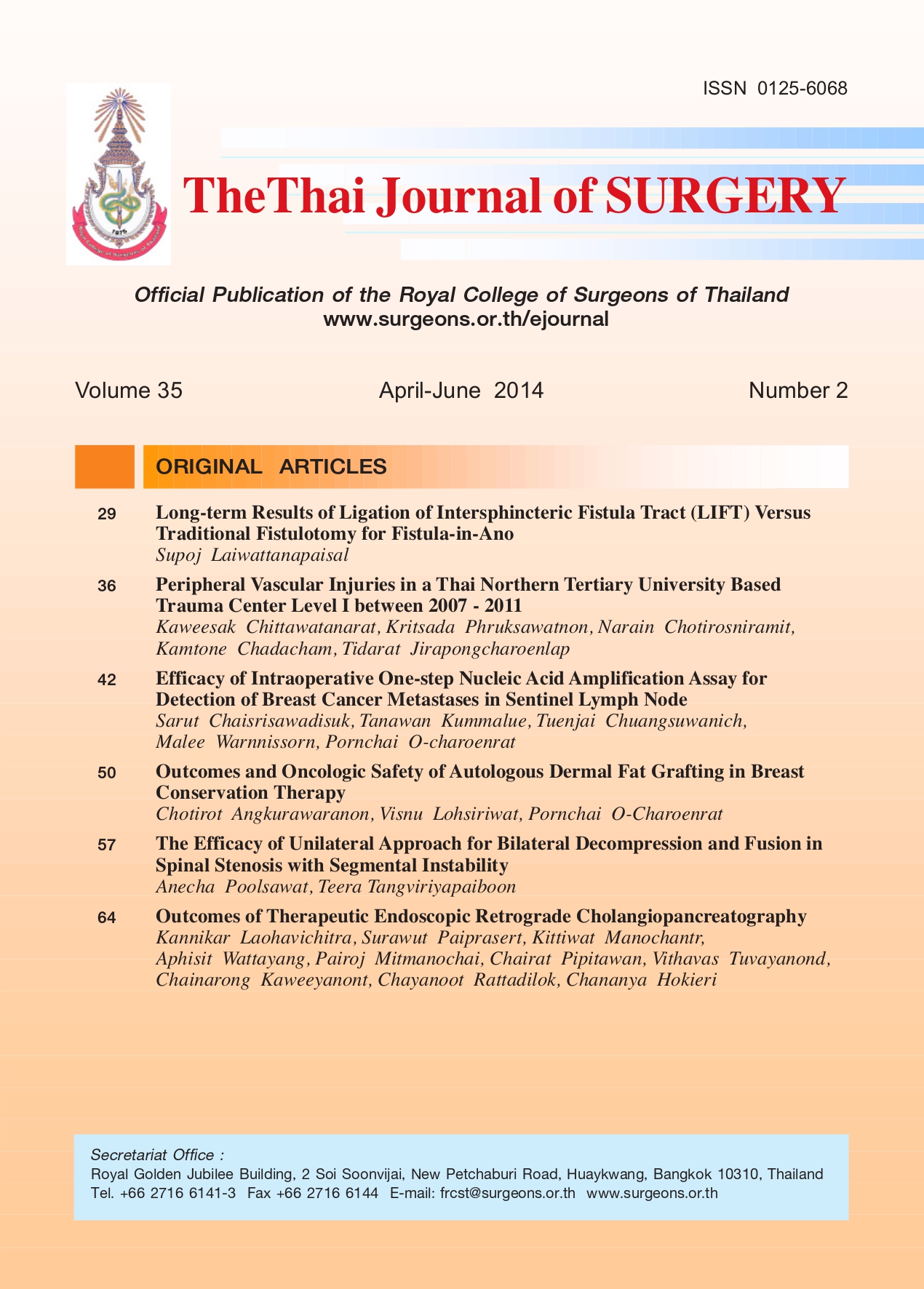Outcomes and Oncologic Safety of Autologous Dermal Fat Grafting in Breast Conservation Therapy
Keywords:
Autologous free dermal fat graft, breast cancer, breast conserving surgery, breast reconstruction, oncoplastic surgeryAbstract
A novel technique of breast reconstruction in breast conserving surgery (BCS) has been introduced by using autologous free dermal fat graft (FDFG). This study is to evaluate the efficacy of using FDFG. From January 2007 to December 2010, cross-sectional medical records reviewed a total of 96 women who underwent wide excision and breast reconstruction with autologous FDFG from the lower abdomen. Patients and tumor characteristics, complications, and disease recurrence were obtained. Follow-up radiologic imaging was performed.The majority of patients (95.8%) received immediate breast reconstruction. The average operative time was 94.2 minutes (range 30-180). The staging was mostly in stage I-II disease (70%). The majority of the patients’ status (92,95.8%) at the last follow-up visit was alive without disease. The overall survival was 98.9% at 199 weeks. The FDFG
complications were reported in 7 patients (7.3%). No major morbidity and mortality complications were noted. The graft survival rate was 97.8% at 199 weeks. There was no correlation between the FDFG complications and the patient’s characteristics, surgical procedure, timing of reconstruction, size, staging, nor adjuvant treatment.
The use of autologous FDFG for breast reconstruction in BCS is efficient for early breast cancer lesions, with
minimal complications and no mortality. This method is valid in detection of local recurrence without interfering with
the radiologic imaging reports which ensures oncologic safety.
References
A, et al. Twenty-year follow-up of a randomized study
comparing breast-conserving surgery with radical
mastectomy for early breast cancer. N Engl J Med
2002;347(16):1227-32.
2. Fisher B, Anderson S, Bryant J, Margolese RG, Deutsch M, Fisher
ER, et al. Twenty-year follow-up of a randomized trial
comparing total mastectomy, lumpectomy, and lumpectomy
plus irradiation for the treatment of invasive breast cancer. N
Engl J Med 2002;347(16):1233-41.
3. Missana MC, Laurent I, Barreau L, Balleyguier C. Autologous
fat transfer in reconstructive breast surgery: indications,
technique and results. Eur J Surg Oncol. 2007;33(6):685-690.
4. Mojallal A, Saint-Cyr M, Garrido I. Autologous fat transfer:
controversies and current indications for breast surgery. J Plast
Reconstr Aesthet Surg 2009;62(5):708-10.
5. Hu E, Alderman AK. Breast reconstruction. Surg Clin North Am
2007;87(2):453-67.
6. Avraham T, Clavin N, Mehrara BJ. Microsurgical breast
reconstruction. Cancer J 2008;14(4):241-7.
7. Greco JA, 3rd, Castaldo ET, Nanney LB, Wu YC, Donahue R,
Wendel JJ, et al. Autologous breast reconstruction: the
Vanderbilt experience (1998 to 2005) of independent
predictors of displeasing outcomes. J Am Coll Surg
2008;207(1):49-56.
8. Kaufman MR, Bradley JP, Dickinson B, Heller JB, Wasson K, O’
Hara C, et al. Autologous fat transfer national consensus
survey: trends in techniques for harvest, preparation, and
application, and perception of short- and long-term results.
Plast Reconstr Surg. 2007;119(1):323-31.
9. Kijima Y, Yoshinaka H, Owaki T, Aikou T. Early experience of
immediate reconstruction using autologous free dermal fat
graft after breast conservational surgery. J Plast Reconstr
Aesthet Surg 2007; 60(5):495-502.
10. Kijima Y, Yoshinaka H, Hirata M, Umekita Y, Sohda M, Koriyama
C, et al. Clinical and pathologic evaluation of implanted free
dermal fat grafts after breast cancer surgery: A retrospective
analysis. Surgery 2012;151(3):444-55.
Downloads
Published
How to Cite
Issue
Section
License
Articles must be contributed solely to The Thai Journal of Surgery and when published become the property of the Royal College of Surgeons of Thailand. The Royal College of Surgeons of Thailand reserves copyright on all published materials and such materials may not be reproduced in any form without the written permission.



